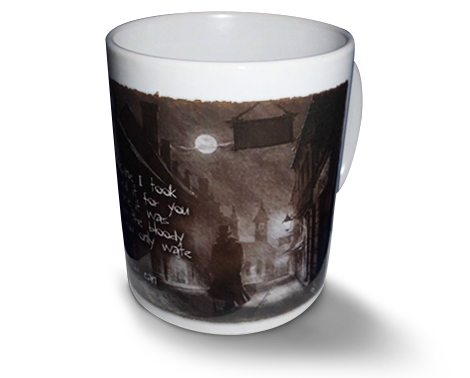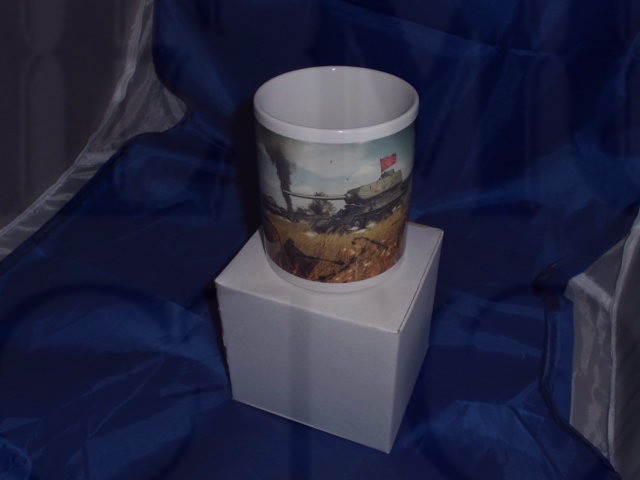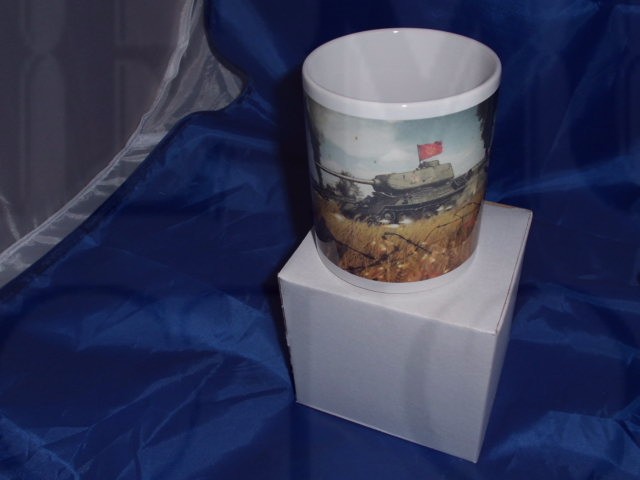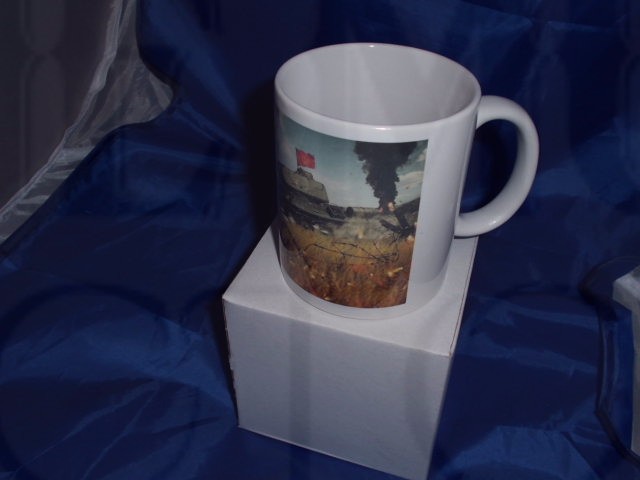T-34/85 Tank military Mug
An accessory that does not discriminate - coffee and tea drinkers alike will always value a great mug. Our T-34 mug withstands the dishwasher, as well as the microwave.
11oz T-34/85 Tank Mug
T34 tank
Citation: C N Trueman "T34 Tank"historylearningsite.co.uk. The History Learning Site, 25 May 2015. 16 Aug 2016.
The T34 tank was developed by the Russians both before and during World War Two. The T34 revolutionised the way tanks were designed and made. Close up in battle, the T34 proved to be more than a match for the powerful Tiger tank. The T34 combined developments from both America and, ironically, Germany.
1931, the Russians purchased two American Christie tanks. The suspension system found on the Christie was incorporated into the T34. It was powered, in general, by a 500-horsepower V-type diesel engine developed from a BMW diesel engine.
The first prototype of the T34 was completed in early 1939. In September 1940, the T34 went into production armed with a 76mm gun. The T34 was accepted for service before official trials had been completed. It was made at six different factories and more T34’s were made than any other tank in World War Two.
The T34 was a very cramped tank as little consideration had been given to the comfort of the crew. The T34 was also considered to be a noisy tank and could be heard from a distance of 450 to 500 metres, thus giving the Germans an early warning as to their whereabouts.
The great value of the T34 was its simple design which made it easy to manufacture and easy to repair. The T34 was also reasonably light while its water-cooled engine made an engine fire rare and increased the distance at which a T34 could operate. The speed of the T34 was also a major advantage over German tanks. The average top speed of German tanks was 25 mph while the T34 had a top speed of 32 mph. Its sloped armour also gave the T34 a very good defence against German shells.
The Russians could afford to lose many T34’s in battle as their factory system allowed for the building of thousands of them. Whereas German factories were bombed by the Allies, the T34 factories based deep in the Ukraine were relatively free from German bombing. When factories were damaged by German bombing, other factories were simply ordered to step up their production to make up the shortfall.
The T34 was later equipped with an 85 mm gun to allow it to compete with the Tiger tanks on the eastern front. Later versions were also given better armour. The T34/85 had a flatter turret, making a smaller target – an innovation that was copied in many tanks after the war.
T34 was a very cramped tank as little consideration had been given to the comfort of the crew. The T34 was also considered to be a noisy tank and could be heard from a distance of 450 to 500 metres, thus giving the Germans an early warning as to their whereabouts.
The great value of the T34 was its simple design which made it easy to manufacture and easy to repair. The T34 was also reasonably light while its water-cooled engine made an engine fire rare and increased the distance at which a T34 could operate. The speed of the T34 was also a major advantage over German tanks. The average top speed of German tanks was 25 mph while the T34 had a top speed of 32 mph. Its sloped armour also gave the T34 a very good defence against German shells.
The Russians could afford to lose many T34’s in battle as their factory system allowed for the building of thousands of them. Whereas German factories were bombed by the Allies, the T34 factories based deep in the Ukraine were relatively free from German bombing. When factories were damaged by German bombing, other factories were simply ordered to step up their production to make up the shortfall.
The T34 was later equipped with an 85 mm gun to allow it to compete with the Tiger tanks on the eastern front. Later versions were also given better armour. The T34/85 had a flatter turret, making a smaller target – an innovation that was copied in many tanks after the war.
A Komatsu D375A-2 pulled an abandoned tank from its archival tomb under the bottom of a lake nearJohvi, Estonia. The Soviet-built T34/76A tank had been resting at the bottom of the lake for 56 years. According to its specifications, it's a 27-tonne machine with a top speed of 53km/h. From February to September 1944, heavy battles were fought in the narrow, 50 km-wide, Narva front in the north-eastern part of Estonia. Over 100,000 men were killed and 300,000 men were wounded there. During battles in the summer of 1944, the tank was captured from the Soviet army and used by the German army. (This is the reason that there are German markings painted on the tank's exterior.) On 19 September 1944, German troops began an organized retreat along the Narva front. It is suspected that the tank was then purposefully driven into the lake, abandoning it when its captors left the area. At that time, a local boy walking by the lake Kurtna Matasjarv noticed tank tracks leading into the lake, but not coming out anywhere. For two months he saw air bubbles emerging from the lake. This gave him reason to believe that there must be an armored vehicle at the lake's bottom. A few years ago, he told the story to the leader of the local war history club 'Otsing'. Together with other club members, Mr. Igor Shedunov initiated diving expeditions to the bottom of the lake about a year ago. At the depth of 7 metres they discovered the tank resting under a 3-metre layer of peat. Enthusiasts from the club, under Mr Shedunov's leadership, decided to pull the tank out. In September 2000 they turned to Mr Aleksander Borovkovthe, manager of the Narva open pit of the stock company AS Eesti Polevkivi, to rent the company's Komatsu D375A-2 bulldozer. Currently used at the pit, the Komatsu dozer was manufactured in 1995, and has 19,000 operating hours without major repairs. The pulling operation began at 09:00 and was concluded at 15:00, with several technical breaks. The weight of the tank, combined with the travel incline, made a pulling operation that required significant muscle. The D375A-2 handled the operation with power and style. The weight of the fully armed tank was around 30 tons, so the active force required to retrieve it was similar. A main requirement for the 68-tonne dozer was to have enough weight to prevent shoe-slip while moving up the hill. After the tank surfaced, it turned out to be a trophy tank, that had been captured by the German army in the course of the battle at Sinimaed (Blue Hills) about six weeks before it was sunk in the lake. Altogether, 116 shells were found on board. Remarkably, the tank was in good condition, with no rust, and all systems (except the engine) in working condition. This is a very rare machine, especially considering that it fought both on the Russian and the German sides. Plans are under way to fully restore the tank. It will be displayed at a war history museum, that will be founded at the Gorodenko village on the left bank of the River Narv. And this description from http://www.diving.ee/articles/art035.html The latest news about T-34.Have successfully started the diesel engine not replacing any spare part.Have replaced only bearings on skating rolls.Assembly of the tank will soon come to the end and it will be ready to trial runs.It is planned in the following season to carry on tourists and to show it as a working exhibit of our museum. The detailed information about T-34.Germans have driven this tank in lake when fuel was terminated at deviation in 1944. It laid on depth of 12 meters. Above it there were 6 meters of peat and silt. During two weeks divers of club washed away silt above the tank. Any traces of solar oil or oil on water was not. Has found the tank Igor Sedunov on memoirs of local residents. A technical condition of the tank ideal. Fuel in tanks was not, and oil did not leave the engine.








